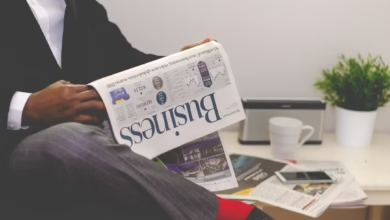Bracing for Impact: Understanding Recessions and Strategies for Resilience

In an ever-evolving global economy, the specter of recession looms as a significant concern for individuals, businesses, and policymakers alike. Understanding the intricate dynamics of economic downturns is crucial for navigating the challenges they present. This article delves into the early warning signs that signal an impending recession, offering insights into how various sectors of the economy are affected. We will explore strategic investment approaches that can help safeguard financial assets during turbulent times, while also examining the critical role government stimulus plays in mitigating the adverse effects of recessionary conditions. Additionally, we’ll discuss the shifts in consumer behavior that often accompany economic decline and the broader implications for global trade and supply chains. By reflecting on lessons learned from past recessions, we aim to equip businesses with strategies to prepare for, adapt to, and ultimately survive economic downturns. Join us as we navigate the complexities of recession and uncover pathways to resilience in uncertain times.
- 1. Recognizing the Red Flags: Early Warning Signs of an Economic Downturn
- 2. Navigating the Storm: Investment Strategies for Recession Resilience
- 3. The Government's Safety Net: Stimulus Measures and Their Impact on Economic Recovery
1. Recognizing the Red Flags: Early Warning Signs of an Economic Downturn
Recognizing the early warning signs of an economic downturn is crucial for businesses, investors, and consumers alike. Several indicators can signal that a recession may be on the horizon.
One of the most commonly observed signs is a decline in consumer confidence. When consumers feel uncertain about the future, they tend to reduce spending, which can lead to decreased demand for goods and services. This decline is often reflected in consumer sentiment surveys and can be a precursor to weaker economic activity.
Another significant indicator is a slowdown in manufacturing and production. Metrics such as the Purchasing Managers' Index (PMI) can provide insights into the health of the manufacturing sector. A reading below 50 typically suggests contraction, which may signal an impending economic slowdown.
Additionally, rising unemployment rates can serve as a red flag. As businesses begin to anticipate lower demand, they may start to lay off employees or halt hiring, leading to increased joblessness. Higher unemployment can further exacerbate consumer confidence issues, creating a vicious cycle.
Changes in the stock market can also provide clues about economic conditions. A sustained decline in stock prices may indicate that investors are losing faith in corporate earnings and economic growth. Furthermore, an inverted yield curve—when long-term interest rates fall below short-term rates—is often viewed as a reliable predictor of an impending recession.
Lastly, shifts in housing market activity, such as falling home sales and declining housing prices, can signal broader economic troubles. The housing market is closely tied to consumer wealth and spending, and weakness in this sector can have ripple effects throughout the economy.
By keeping a close eye on these indicators, stakeholders can better prepare for potential economic downturns and make informed decisions to mitigate risks associated with recessionary periods.
2. Navigating the Storm: Investment Strategies for Recession Resilience
During a recession, investors often face heightened uncertainty and volatility in the markets. However, employing specific strategies can help navigate these turbulent times and potentially capitalize on opportunities. One key approach is to focus on defensive stocks, which are shares in companies that tend to perform relatively well during economic downturns. These often include sectors such as utilities, healthcare, and consumer staples, as they provide essential goods and services regardless of the economic climate.
Another strategy is to consider diversifying into bonds, especially government bonds, which are generally seen as safer investments during a recession. Fixed-income securities can offer more stability and provide a steady income stream, serving as a buffer against the fluctuations of the stock market.
Investors may also consider increasing their allocation to cash or cash equivalents. Having liquidity allows for the flexibility to take advantage of lower asset prices during a market downturn. This strategy can position investors to make timely purchases when opportunities arise, as distressed assets may present significant long-term value.
Additionally, focusing on dividend-paying stocks can be advantageous. Companies that are able to maintain or grow their dividends often have strong fundamentals and cash flow management, making them more resilient during challenging economic times. This approach not only provides potential income but can also lead to capital appreciation as the economy recovers.
Lastly, investors should remain vigilant and continuously assess their portfolios. Regularly reviewing asset allocations and performance can help identify underperforming areas that may need adjustment. By staying informed and adaptable, investors can better position themselves to weather the storm of a recession and emerge stronger when the economy rebounds.
3. The Government's Safety Net: Stimulus Measures and Their Impact on Economic Recovery
During economic downturns, governments often implement stimulus measures as a safety net to support individuals and businesses, aiming to mitigate the adverse effects of a recession and foster recovery. These measures can take various forms, including direct financial assistance to citizens, tax cuts, increased government spending on infrastructure, and support for specific industries. The primary goal is to inject liquidity into the economy, stimulate demand, and prevent further economic contraction.
Direct payments to households, such as stimulus checks or expanded unemployment benefits, can provide immediate relief to those most affected by job losses and reduced income. By increasing disposable income, these payments encourage consumer spending, which is vital for driving economic growth. Similarly, tax incentives can incentivize businesses to invest and hire, promoting job creation and economic activity.
Infrastructure spending is another critical component of stimulus measures. By investing in public works projects, governments can create jobs and improve essential services. This not only provides immediate employment opportunities but also lays the groundwork for long-term economic growth by enhancing productivity and connectivity.
The effectiveness of these stimulus measures often depends on their design and implementation. Timely and well-targeted interventions can lead to quicker economic recovery, while poorly executed measures may result in inefficiencies and delayed recovery. Historical examples, such as the U.S. government's response to the 2008 financial crisis, demonstrate the potential for stimulus measures to stabilize the economy, although the long-term impacts can vary.
Overall, government stimulus acts as a crucial safety net during economic downturns, helping to cushion the blow for individuals and businesses while laying the foundation for recovery. By understanding the role and impact of these measures, policymakers can better navigate future recessions and bolster economic resilience.
In conclusion, understanding the dynamics of economic recessions is crucial for individuals, businesses, and policymakers alike. By recognizing early warning signs, such as declining consumer confidence and rising unemployment rates, stakeholders can take proactive measures to mitigate the effects of a downturn. Different sectors of the economy respond variably to recessions, underscoring the importance of tailored investment strategies that prioritize resilience and adaptability. Government stimulus plays a pivotal role in cushioning the impact of economic shocks, fostering recovery, and ensuring stability.
Moreover, shifts in consumer behavior during downturns necessitate that businesses remain agile, adjusting their offerings and marketing strategies to align with changing priorities. The global interconnectedness of trade and supply chains means that the repercussions of a recession can ripple across borders, affecting economies worldwide. Lessons learned from past recessions provide valuable insights into effective preparation and response strategies, enabling businesses to not only survive but potentially thrive in challenging times.
As we navigate the complexities of the economic landscape, it is essential to foster a mindset of resilience and adaptability. By staying informed and strategically planning for potential downturns, we can better position ourselves to weather the storm and emerge stronger on the other side.





